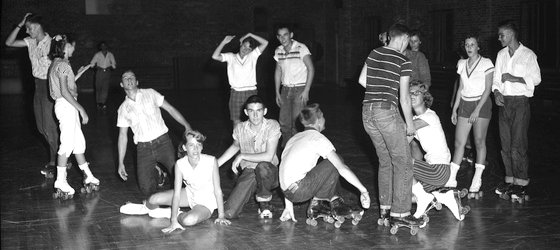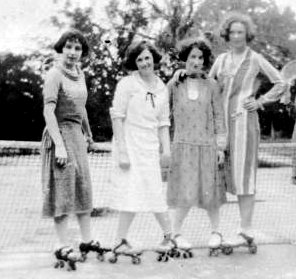Roller Skating in Tallahassee
by J. Kent Thompson
|
If you grew up in Tallahassee you probably enjoyed the thrill and terror of roller skating as a kid. Many in the 30s and 40s frequented the skating rink at the bottom of South Monroe just past the underpass or on rinks located at the city parks. Most from the 50s and 60s remember skating at the Armory on Monroe and Seventh Avenue. We also skated on the streets in metal wheeled skates, secured snugly to our shoes by tightening them with a skate key. If you were born in the 80s you probably went to Skate Inn East or West. Most of my memories include falls on the hard wooden floors at the Armory or rocketing towards its brick wall, trying to stop before colliding with the benches lining them. Other memories include attending friends birthday parties at the Armory or taking my kids to parties at the Skate Inn’s. Regardless of how or when, roller skating is part of our Tallahassee heritage.
 Teenagers skating at the Leon County Armory in Tallahassee, Florida. July 27, 1957 (Photo: State Archives of Florida)
As early as 1907 Tallahassee youth were enjoying roller skating, sometimes to their peril. The Daily Democrat reported that both Mosley Collins and Ben Chaires had fallen and broken bones. In the late 1920s certain sections of city streets were for designated for skating including Park Avenue between Macomb and Copeland, Adams between Virginia and Tennessee, and later the block between Carolina and Georgia. Because skating was becoming such a fad with children on the streets and sidewalks, people began to complain citing a danger to the children and drivers. Tallahassee Chief of Police E.R. Isler ordered there would be no skating allowed after ten o’clock.
The Pastime Roller Rink came to Tallahassee for a limited engagement before Christmas in 1926. Its popularity resulted in a shortage of skates for Christmas presents. The rink lured skaters with promises of free boxes of candy and held a race for the skating championship of Tallahassee between local youths Earl Andrews and Durward Drudge. More temporary rinks would spring up requiring the city to pass an ordinance prohibiting the operation of rinks between 10:30 p.m. and 8:00 a.m.
 Skating on theTennis courts at Goodwood - Tallahassee, Florida - April 11, 1926. (Photo: State Archives of Florida)
Tallahassee’s first permanent modern skating rink opened in 1933. It was located on the northeast corner of Adams and College street in the old Yates building behind the W. and W. Athletic Club. Skating opened from 3:30 to 11:00 each day for except Tuesdays, when the site was used for boxing matches. Managed by Wade Wehunt, it cost 25 cents per session or 40 cents for two sessions. The growing popularity of skating resulted in the city passing an ordinance requiring all skates used on city streets to be constructed of rubber, fiber or other running surfaces, but not metal. The ordinance further designated the operation of skating rinks to an area bordered by Park Avenue on the north, Pensacola street on the south, Calhoun street on the east and Adams street on the west.
On December 6,1933 Tallahassee’s new skating rink was destroyed by a fire. A lit cigarette discarded during a Tuesday night boxing match was determined to be the culprit. The fire consumed the Athletic Club, the State Theater, the Venetia Restaurant and Hotel and other businesses. It even threatened the neighboring Daily Democrat office on Adams street. In total the fire caused a quarter of a million dollars in damage.
Local service clubs quickly decided that Tallahassee needed a place for children and adults to go to enjoy recreational activities. A building on property bordered by Adams and S. Monroe just below the underpass was designated as Recreation Park. The building, known later as the White House, had a sealed maple floor and offered a place to skate, dine, dance, box and wrestle. By 1934 its venue was expanded to offer local theater plays. Managed by Fred D. Hartsfield, it was advertised as the only air-cooled rink in Florida. Skaters were charged 25 cents per session or 40 cents for two sessions. Spectators could come in for free and were invited to lounge on upholstered davenports and watch the skaters. Tuesday’s were reserved for boxing matches. In 1934 a 100-mile skating marathon was announced, and teams were invited to enter. Three teams entered: C.J. Jower’s and Peanut Simms, Paul Hartsfield and A.T. Strickland, and Allen and Parker. To skate 100 miles the contestants had to complete 2011 laps around the rink. The team of Jower’s and Simms won in six hours and thirty-one minutes.
Street skating continued to be a problem in the city. In 1936 Chief of Police Gid Powledge initiated a drive to keep children off the streets. At the time the only ordinance affecting street skating forbid it in the busines area between St. Augustine and Tennessee streets. To curb the street skating Chief Powledge lobbied Leon High principal M.L. Stone to forbid students from bringing skates to school. To better manage street skating it was decided to open the street in front of Sealy Memorial on West 7th Avenue, and on West Park Avenue between Boulevard and Monroe at nights between 7 and 9 p.m.
In 1940 the city provided a private skate rink north of Park Avenue between Boulevard and Macomb for skating every Friday from 3 to 10 p.m. Some lucky skaters were invited to the private rink at Goodwood, others made their own rinks at places like the circular driveway at the Governor’s mansion.
In December of 1947 the Mercury Roller Rink opened its doors at 1206 South Monroe in the old Recreation Park building. It was managed by Thomas Fletcher and L.T. Little. A competitor rented the Armory and offered skating, much to the dismay of local residents who complained of the noise. The Chief of Police, reacting to the complaints, said he would have them turn down the volume on their “jook organ.”
The city continued to offer places for children to skate including Doug Burnette, Winthrop, Levy and Lafayette parks. In early 1950 the City Recreation board proposed to rent the Armory on 7th Avenue and buy $2,000 worth of skating equipment from L.T. Little to offer skating and other recreational activities. The deal included skates, shoes, repair tools, lockers, a record player and amplifier. The idea was accepted but later rejected when private rink operators complained it would shut down their business’s. The skating rink on South Monroe continued to operate, now called the Tallahassee Skating Rink operated by Dr. Barton Hall.
In 1955 the City Recreation Department decided to host a skating night at the Armory as a test to gage Tallahasseeans interest in attending regular skating sessions. The Department had been renting the Armory for junior and senior high dances on Friday and Saturday nights with some success. If skating proved popular, they wanted to include a skating night. That first night 125 skaters showed up and thus began regular Thursday night skating at the Armory.
The city started sponsoring skating at the Armory in June of 1956 opening every Saturday from 8 to 11 p.m. with one catch, you had to bring your own skates. By September the city had purchased 132 pairs of skates and offered a Saturday morning session for youngsters under 13 from 9 to 11:15 a.m. The night skating sessions were changed to 6:30 to 8:30 and 9 to 11 p.m. for elementary through high school. By 1957 the number of skates available had increased to 200.
The program was managed by Jim Harkins of the City Recreation Department. Assisting him was Charles Mason who rented the skates, played the records and called the dances, Miss Sue Herndon the cashier, and Jim Haywood, local FSU Circus star, who was the skating floor manager and instructor. It cost ten cents to skate if you brought your own skates or you could rent a pair for twenty-five cents. In 1959 Dalton Allen, the physical-education teacher at Ruediger Elementary, was hired to operate the skating program.
Skating at the Armory would continue to be popular through the 1980s. Many local children rented the rink for birthday parties at a cost of $10 for forty people. In 1979 the city purchased the Armory building from the county, and many wanted to end skating in favor of making it a senior citizens center. A compromise was reached to share the facility between skating, senior citizens, square dancing, and dog obedience classes. The city sponsored skating program ended in 1986 a victim of competition from two local private skating rinks. The two private rinks were Skate Inn East located on Capitol Circle and Skate Inn West (1973-2017) on the Blountstown Highway. The City of Tallahassee would later get back into the skating business to promote their winter festival, setting up a temporary ice-skating rink at the Civic Center and the development of the Mike Blankenship Skate Park for skateboarders. Today one can still find places to roller skate and make memories. Be it the Skate World Center, the Tallahassee Skate Inn, Tallahassee Indoor Sports, or the secret skate park behind the old Gramling’s, the thrill and terror of roller skating remains available.
|
Kent Thompson's ![]() e-mail
e-mail